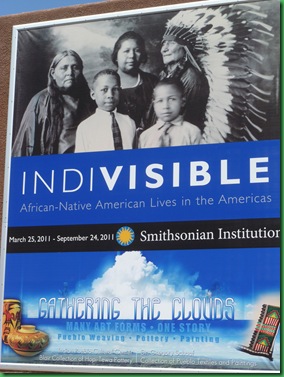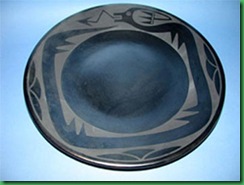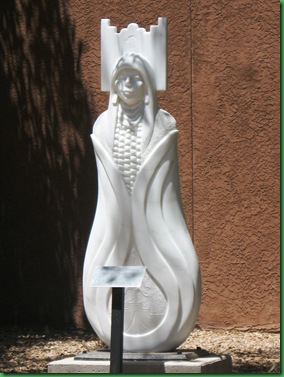Friday May 27, 2011
Enchanted Trails RV Park
Albuquerque, New Mexico
Enchanted Trails RV Park
Albuquerque, New Mexico
Caution:
In an effort to get this blog caught up to where we actually are right now,
I have published 3 posts in less than 24 hours.
If you want to know everything we’ve done
(why in the world would you?)
you will have to go back to Wednesday’s
Leaving Tucumcari
then read through
a VERY full day
and arrive here at Indian Pueblo Culture Center.
That’s done by scrolling down and
reading in reverse order.
Very likely I will do this 3 post thing again tomorrow.
Buyer beware :-)))
We were up and out this morning at 6:30
running the supremely boring Frontage Road
until I couldn’t take it anymore.
running the supremely boring Frontage Road
until I couldn’t take it anymore.
One omelet breakfast later and we were
at the Pueblo Indian Culture Center
at 11am.
David asked yesterday when we came in to look around,
how long it would take to do the exhibits
and was told about 90 minutes.
Clearly she doesn’t know us
as you will see. :-)
at the Pueblo Indian Culture Center
at 11am.
David asked yesterday when we came in to look around,
how long it would take to do the exhibits
and was told about 90 minutes.
Clearly she doesn’t know us
as you will see. :-)
The building is fabulous.
This is a close up of the simply
outstanding sculpture in the front courtyard.
The Native Americans are very proud
of their warriors from all times.
outstanding sculpture in the front courtyard.
The Native Americans are very proud
of their warriors from all times.
Once inside we found a round entry rotunda
and that many of the other areas had curved walls
including the courtyard.
A very unique design.
and that many of the other areas had curved walls
including the courtyard.
A very unique design.
The Rotunda had an interesting exhibit
on the Buffalo Soldiers and
their relationship to the Native Americans.
on the Buffalo Soldiers and
their relationship to the Native Americans.
Just outside the Rotunda was the Center’s Mission Statement.
Just beyond the Mission Statement was
this wonderful bronze sculpture
Nurtured by Prayer
by Joe Cajero of Jemez Pueblo.
this wonderful bronze sculpture
Nurtured by Prayer
by Joe Cajero of Jemez Pueblo.
It is titled
Sisters Sunrise and Sunset.
Sisters Sunrise and Sunset.
front side/opposite side
The next “South Gallery” presentedIndivisible:
African-Native American Lives in Americaan equally interesting exhibit, display and video documentary
produced originally by the National Museum of the American Indian,
the National Museum of African American History and Culture
and the Smithsonian Institution Traveling Exhibition Service.
African-Native American Lives in Americaan equally interesting exhibit, display and video documentary
produced originally by the National Museum of the American Indian,
the National Museum of African American History and Culture
and the Smithsonian Institution Traveling Exhibition Service.
It was an EXCELLENT presentation of
the connection between the African and Native Americans
as people faced with “centuries of government policies and laws that systematically oppressed and excluded them.”
Though they share many experiences as oppressed minorities,
I had never thought about a number of the ideas presented here
Such as that “the majority the African and Native music
relies heavily on the playing of drums and remains one of
the most unifying cultural, artistic and spiritual
commonalities among the African and Native Peoples.”
the connection between the African and Native Americans
as people faced with “centuries of government policies and laws that systematically oppressed and excluded them.”
Though they share many experiences as oppressed minorities,
I had never thought about a number of the ideas presented here
Such as that “the majority the African and Native music
relies heavily on the playing of drums and remains one of
the most unifying cultural, artistic and spiritual
commonalities among the African and Native Peoples.”
I was also unaware that in their useless effort to assimilate,
the East coast Cherokees imitated their white neighbors
and owned African slaves.
These Africans were also forced to go on
the Trial of Tears in forced removal to Oklahoma.
Nor was I aware that there are a large number
of Afro-Indians including Jimi Hendrix.
of Afro-Indians including Jimi Hendrix.
The music in the 10 minute DVD running in
the exhibit room added greatly to the experience.
Sure wish they had made a "sound track".
the exhibit room added greatly to the experience.
Sure wish they had made a "sound track".
We were permitted to take photographs only
in these two exhibits. But not in the remainder of the
Center or the museum on the lower level.
in these two exhibits. But not in the remainder of the
Center or the museum on the lower level.
We moved on into the
Gathering of the Clouds Exhibit
Gathering of the Clouds Exhibit
This was a beautiful installation show casing
both ancient and modern weaving and pottery
along a background of the broad New Mexico sky filled with clouds.
both ancient and modern weaving and pottery
along a background of the broad New Mexico sky filled with clouds.
Really beautiful job.
The craftsmanship was remarkable.All artists are featured through the Center are members of
Native Pueblo Tribes.
These are a very talented people.
It was amazing how the design traditions and
methods have continued through the centuries.
In some cases we could not tell the which
shawls, sashes or bowls were made in
the 18th century and which were made within
the past 20 years without looking at the tags.
Also in this exhibit were two very interesting
short films about local Pueblo artists.
One is titled, Maria: Native American Pottery Maker of San Ildefonso,
and is about Maria Martinez,
renowned potter from the Pueblo of San Ildefonso.
short films about local Pueblo artists.
One is titled, Maria: Native American Pottery Maker of San Ildefonso,
and is about Maria Martinez,
renowned potter from the Pueblo of San Ildefonso.

The other film is titled, Pablita Velarde: An Artist and Her People,
and features Velarde, a Santa Clara painter.

At the time of the films’ production,
both of these women were elderly
and were continuing their crafts and the
traditions of their people.
Martinez died in 1980 at the age of 93.Pablita Velarde died in 2006 at the age of 88.
both of these women were elderly
and were continuing their crafts and the
traditions of their people.
Martinez died in 1980 at the age of 93.Pablita Velarde died in 2006 at the age of 88.
At this point, we had spent 3 hours,
were only half way through the Center’s
exhibits and decided it was time for lunch
which we ate in an outside patio.

were only half way through the Center’s
exhibits and decided it was time for lunch
which we ate in an outside patio.

The statue there in the courtyard was
of a corn maiden. It was lovely.
The artwork here is just tremendous.
of a corn maiden. It was lovely.
The artwork here is just tremendous.
After lunch, we were feeling the press
of time as the Center closes at 5PM
and it was clear we were not going to
be able to take our usual leisurely pace
through the remaining exhibit
AND have time to do the lower level museum.
of time as the Center closes at 5PM
and it was clear we were not going to
be able to take our usual leisurely pace
through the remaining exhibit
AND have time to do the lower level museum.
We did a very hurried walk through “The Saints of the Pueblos”exhibit of 23 retablos created by santero,
a carver and painter of images of the saints,
Charles M. Carrillo.
Carrillo is nationally known for creating art using
Spanish colonial techniques that reflect
18th Century Spanish New Mexico.
This exhibit depicted the patron saint of each Pueblo Indian tribe
including four ancestral pueblos no longer inhabited.
a carver and painter of images of the saints,
Charles M. Carrillo.
Carrillo is nationally known for creating art using
Spanish colonial techniques that reflect
18th Century Spanish New Mexico.
This exhibit depicted the patron saint of each Pueblo Indian tribe
including four ancestral pueblos no longer inhabited.
These were displayed against church courtyard landscapes
created by local muralists. This exhibit is owned
in common by the 19 Pueblo Indian Tribes of New Mexico,
I wish we had more time to spend in it.
But choices have to be made.
created by local muralists. This exhibit is owned
in common by the 19 Pueblo Indian Tribes of New Mexico,
I wish we had more time to spend in it.
But choices have to be made.
We finished our day in the Museum
which has excellent displays on
Pueblo life, art & history
from 1200AD to the present.
Half of the museum is devoted to the
history and half is made up of
individual presentations on each
of the 19 Pueblos showing the pueblo acreage,
number of current members
and which Native language they speak.
All had displays of crafts for which their people are known.
Most had an enlarged photograph of
the Pueblo taken between 1880 and 1910
as well as a summary of their history
on their land up to the present day.
The information presented was both
fascinating and educational.
which has excellent displays on
Pueblo life, art & history
from 1200AD to the present.
Half of the museum is devoted to the
history and half is made up of
individual presentations on each
of the 19 Pueblos showing the pueblo acreage,
number of current members
and which Native language they speak.
All had displays of crafts for which their people are known.
Most had an enlarged photograph of
the Pueblo taken between 1880 and 1910
as well as a summary of their history
on their land up to the present day.
The information presented was both
fascinating and educational.
And if all this isn’t enough,
the Center has a theater on the
lower level which shows 4
professionally done documentary films
related to the subjects of their exhibits.
These range in length from 28 minutes to 60
minutes.
the Center has a theater on the
lower level which shows 4
professionally done documentary films
related to the subjects of their exhibits.
These range in length from 28 minutes to 60
minutes.
We were only able to fit in one
Singing our Stories which was about Native
Women Singers including Walela, Ulali, Pura Fe
and others whose music I love. I was really
surprised and excited to see it was the one
playing when we had time for the theater.
Singing our Stories which was about Native
Women Singers including Walela, Ulali, Pura Fe
and others whose music I love. I was really
surprised and excited to see it was the one
playing when we had time for the theater.
We closed the theater down at 5:10 and wished we’d
had at least another 3 hours to spend in this great
cultural center. If you are ever in Albuquerque,
DO NOT miss it or the Pueblo Harvest Cafe.
had at least another 3 hours to spend in this great
cultural center. If you are ever in Albuquerque,
DO NOT miss it or the Pueblo Harvest Cafe.


















Thanks for the tour. We have put this on our TODOS list ;o))
ReplyDeleteYou covered everything in the museum so well that we can cross it off our bucket list. Thing of the fuel money you just saved me! ;c)
ReplyDeletePaul & Marti,
ReplyDeleteyou'll be sorrrrreeeee if you miss seeing the more than half of the museum in which I was not allowed to take pictures. Besides you have to go see all the films I didn't get to see and blog about those so I know what I missed. :-)